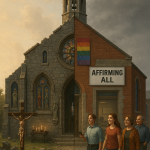Back in England in 1859, Blessed John Henry Newman was having a conversation with Birmingham Bishop William Ullathorne, when the topic of laypeople in the Church arose. As Newman recalled the conversation, Ullathorne asked rhetorically, “Who are the laity?” Newman replied that “the Church would look foolish without them.”
This new blog feature proposes to highlight individual lay men and women from across the country. None achieved great fame in their lifetime, but they did make an important contribution to the local Church as parishioners, church benefactors, religious educators, and leaders of lay organizations. They were no less a part of the making of Catholic America than their bishops, priests, sisters and brothers. And we shouldn’t miss an opportunity to celebrate their memory.
This week’s first entry comes from Father Thomas Donohoe’s 1904 book, History of the Catholic Church in Western New York: Diocese of Buffalo:
John Patrzykowski, since 1890 a resident of Buffalo, N.Y., was born in Trzemeszno, Poland, December 27, 1846; the son of Thomas and Antoinette Skora Patrzykowski, and educated in the Trzemeszno Gymnasium. A staunch patriot and organizer in the cause of Poland, he, when but eighteen years of age, suffered six months’ imprisonment in a Russian dungeon for love of his country. In 1870 Mr. Patrzykowski came to the United States and while living in New York organized the largest Republican Polish club ever formed in that city. He is engaged in the wholesale liquor business, is an active member of the East Buffalo Business Men’s Association and as a parishioner of St. John Kanty Church, closely identified with its affairs. Mr. Patrzykowski married Miss Leokadya Klpeiszewska. They have a family of four children, Julia, Frances, Casimir and Alexander.
NOTE
John Patrzykowski is seen above wearing medals from his participation in Poland’s January Uprising of 1863. He was also a parish trustee for Assumption of the Blessed Virgin Mary Church, a Polish parish founded in Buffalo’s Black Rock section in 1888. His store was located at 1119 Broadway. His son Alexander was elected to the New York State Assembly, serving between 1917 and 1922. No information is available on John’s passing. Polish immigration to Buffalo and Western New York began in large numbers around the year 1870, following the failed uprising against Russian rule. By 1940, there were over 75,000 people of Polish descent in this region. Today the University at Buffalo has a Polish Studies Program.













